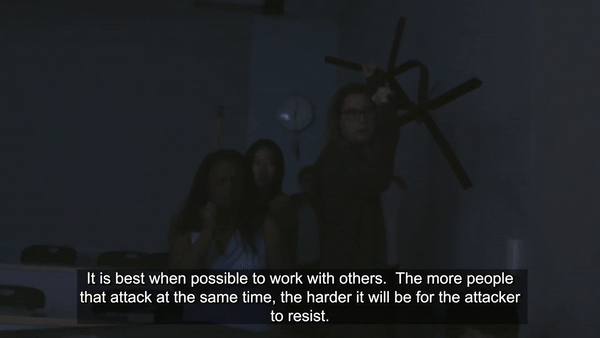Explained: Why NYU told you to ‘fight’ with an active shooter
Gunshots in Brooklyn led to an NYU community-wide alert advising those in the area to “run, hide or fight.” The advice, which originated from the federal government, has garnered confusion and criticism from students and safety advocates.

An excerpt from the NYU’s Active Threat Preparedness Video demonstrating how to “fight” against a gunman. (Courtesy of NYU)
October 5, 2022
Students at NYU’s downtown Brooklyn campus on Tuesday were advised to “run, hide, or fight” in response to a shooter, after reports of multiple gunshots near campus buildings. The instructions, which came in an alert from the Campus Safety Department shortly after the incident, received criticism from students confused by the actions it recommended.
After the initial alert, students took to Twitter, with one calling Campus Safety’s “run, hide or fight” advice “unhinged.” Another asked that the department change its language to avoid advising students to fight armed attackers.
NYU’s emergency response protocol — which includes the specific “run, hide, fight” model — comes directly from New York state’s official recommendations, according to university spokesperson John Beckman.
“The phrase is meant to convey to people that in an active shooter situation, the best option is to run — to get out of the path or range of the shooter,” Beckman said. “The second best option is to hide, so you will be less likely to be a target. And the last option, if you cannot avail yourself of the first two, is to fight for your life. NYU produced its own very compelling video on run, hide, fight just a few years ago, with expert input.”
NYU produced an active threat preparedness video which expands on the “run, hide, fight” recommendation. The video encourages students to barricade doors, refrain from hiding in large groups and work with others to attack and disarm an attacker. The video also notes that during an active shooter situation, officers are focused on eliminating the threat and may not stop to provide medical care. In addition to offering online resources, the university holds monthly active threat training sessions led by Campus Safety officers.
In NYU’s active threat response guidelines, the “run, hide, fight” recommendation is contextualized, including an explanation that “run” and “hide” precede the “fight” option, and that individuals should only confront a shooter as a last resort — with a group if possible. This context was omitted in the short text alert sent by Campus Safety at the time of the incident, which only advised students to “run, hide, or fight.”
The U.S. Department of Homeland Security and the Federal Bureau of Investigation also recommend that individuals who find themselves in an active shooter situation first evacuate the area or seek cover and then only consider the “fight” approach as a last resort.
The City of New York’s guidelines use different language, recommending that individuals “avoid, barricade, confront” in active shooter situations. The New York City Police Department has also used the “avoid, barricade, confront” model, often abbreviated to “ABC.”
Like NYU, the City College of New York uses the Homeland Security Department’s guidelines for responding to an active shooter, though many other New York City schools, like Columbia University, Fordham University and Brooklyn College, deviate from both DHS and city officials in their wording. Columbia University does not make recommendations about confronting armed attackers.
Some safety advocates, including Kenneth Trump — the president of National School Safety and Security Services — have raised concerns about models like “run, hide, fight,” arguing that traditional lockdown methods are safer in active shooter situations. Kenneth Trump has said that the model may create dangerous confusion, as it runs contrary to lockdown advice typically given in active shooter situations.
Contact Tori Morales at [email protected]
























































































































































